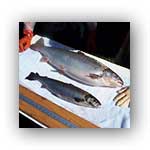|
This fall the U.S. Food and Drug Administration (FDA) is expected to decide on the first-ever genetically engineered (GE) nonplant food source for human consumption—a proposal by Massachusetts-based AquaBounty to sell sterile eggs of a salmon with genetic material from the Chinook salmon and the ocean pout inserted for fast growth. Growers who buy the eggs can raise market-size salmon in 16–18 months instead of three
years.

CNN has reported that salmons don't usually grow in the warm weather, but with this engineered version, the growth hormones added to the genetic code, will enable the fish to grow all year round.
During a two day Public Meetings on Genetically Engineered Atlantic Salmon, some of the key areas being hashed out is the labeling of the fish. The FDA only requires a product to state that it's engineered, if it's very different from like brands on the market.
Consumers may never even know they are purchasing the altered fish because Aquabounty is claiming that this salmon is very similar to the natural ones now on the market. And what about the absence of any long term study on the effects consumption of this fish would have on the general public?
As described in GFI 187,2 the FDA requires a proposed GE change be stable for at least two noncontiguous generations sampled across a minimum span of three generations. The agency examines the health of the animal and the safety of any products from those animals that are consumed by humans, and assesses risk to the environment given the description of how the animal will be raised. The FDA uses a risk-based assessment of potential hazards and likelihood of
harm.
In the case of the AquaBounty AquAdvantage® salmon, only sterile female eggs will be sold to growers, and the fish will be grown in contained inland systems, according to the company’s application to the FDA. The main environmental concerns with the AquAdvantage salmon involve the possible impact on wild salmon, specifically the possibility that some eggs might not be sterile and end up being fertilized, and that the transgenic salmon might thus get established in marine ecosystems, where they could influence wild relatives, says Calestous Juma, director of the Science, Technology and Globalization Project at Harvard University.
Learn more at:
Genetically Engineered Salmon on the FDA’s Table
FDA Public Meetings on Genetically Engineered Atlantic Salmon
BRIEFING PACKET - Food and Drug Administration
Center for Veterinary Medicine
Veterinary Medicine Advisory Committee September 20, 2010 - AquAdvantage Salmon This Briefing Packet has been produced to serve several
purposes.
First, it provides an overall summary of FDA’s risk-based, scientific process for determining the safety and effectiveness of the AquAdvantage Salmon1 produced by Aqua Bounty Technologies Inc. Safety includes safety to the recipient
animal, and the safety of the food from that lineage of
animals; effectiveness refers to whether the article consistently and uniformly does what the sponsor claims it is supposed to do.
Second, it provides data and information that the agency evaluated as part of the application
process, as well as the agency’s evaluations. In
addition, it includes an environmental assessment and the agency’s
analysis. Third, it continues to meet the agency’s commitment to transparency by providing both the Veterinary Medicine Advisory Committee
(VMAC) and the public with the same data and information that the agency evaluated in the review of an application for the approval related to the AquAdvantage
Salmon. The VMAC will be charged with providing scientific advice to the agency; this document is intended to provide the scientific and regulatory information that will help in discharging those
duties. Finally, in the event that the agency approves Aqua Bounty’s
application, this document will serve as the basis for the Freedom of Information
(FOI) summary that normally accompanies new animal drug
approvals. The FOI Summary will also contain additional information such as the approved drug
label, additional information on post-market
responsibilities, and other administrative
information.
New York Times
(MDN)
|
![]()